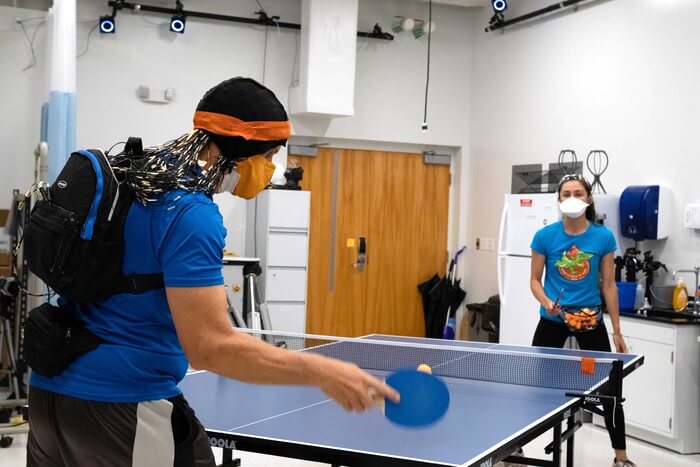Captain of her high school tennis team and a four-year veteran of varsity tennis in college, Amanda Studnicki had been training for this moment for years.
All she had to do now was think small. Like ping pong small.
For weeks, Studnicki, a graduate student at the University of Florida, served and rallied against dozens of players on a table tennis court. Her opponents sported a science-fiction visage, a cap of electrodes streaming off their heads into a backpack as they played against either Studnicki or a ball-serving machine. That cyborg look was vital to Studnicki’s goal: to understand how our brains react to the intense demands of a high-speed sport like table tennis – and what difference a machine opponent makes.
Studnicki and her advisor, Daniel Ferris, discovered that the brains of table tennis players react very differently to human or machine opponents. Faced with the inscrutability of a ball machine, players’ brains scrambled themselves in anticipation of the next serve. While with the obvious cues that a human opponent was about to serve, their neurons hummed in unison, seemingly confident of their next move.
The findings have implications for sports training, suggesting that human opponents provide a realism that can’t be replaced with machine helpers. And as robots grow more common and sophisticated, understanding our brains’ response could help make our artificial companions more naturalistic.
“Robots are getting more ubiquitous. You have companies like Boston Dynamics that are building robots that can interact with humans and other companies that are building socially assistive robots that help the elderly,” said Ferris, a professor of biomedical engineering at UF. “Humans interacting with robots is going to be different than when they interact with other humans. Our long term goal is to try to understand how the brain reacts to these differences.”
Ferris’s lab has long studied the brain’s response to visual cues and motor tasks, like walking and running. He was looking to upgrade to studying complex, fast-paced action when Studnicki, with her tennis background, joined the research group. So the lab decided tennis was the perfect sport to address these questions with. But the oversized movements – especially high overhand serves – proved an obstacle to the burgeoning tech.
“So we literally scaled things down to table tennis and asked all the same questions we had for tennis before,” Ferris said. The researchers still had to compensate for the smaller movements of table tennis. So Ferris and Studnicki doubled the 120 electrodes in a typical brain-scanning cap, each bonus electrode providing a control for the rapid head movements during a table tennis match.
With all these electrodes scanning the brain activity of players, Studnicki and Ferris were able to tune into the brain region that turns sensory information into movement. This area is known as the parieto-occipital cortex.
“It takes all your senses – visual, vestibular, auditory – and it gives information on creating your motor plan. It’s been studied a lot for simple tasks, like reaching and grasping, but all of them are stationary,” Studnicki said. “We wanted to understand how it worked for complex movements like tracking a ball in space and intercepting it, and table tennis was perfect for this.”
The researchers analyzed dozens of hours of play against both Studnicki and the ball machine. When playing against another human, players’ neurons worked in unison, like they were all speaking the same language. In contrast, when players faced a ball-serving machine, the neurons in their brains were not aligned with one another. In the neuroscience world, this lack of alignment is known as desynchronization.
“If we have 100,000 people in a football stadium and they’re all cheering together, that’s like synchronization in the brain, which is a sign the brain is relaxed” Ferris said. “If we have those same 100,000 people but they’re all talking to their friends, they’re busy but they’re not in sync. In a lot of cases, that desynchronization is an indication that the brain is doing a lot of calculations as opposed to sitting and idling.”
The team suspects that the players’ brains were so active while waiting for robotic serves because the machine provides no cues of what they are going to do next. What’s clear is that our brains process these two experiences very differently, which suggests that training with a machine might not offer the same experience as playing against a real opponent.
“I still see a lot of value in practicing with a machine,” Studnicki said. “But I think machines are going to evolve in the next 10 or 20 years, and we could see more naturalistic behaviors for players to practice against.”


